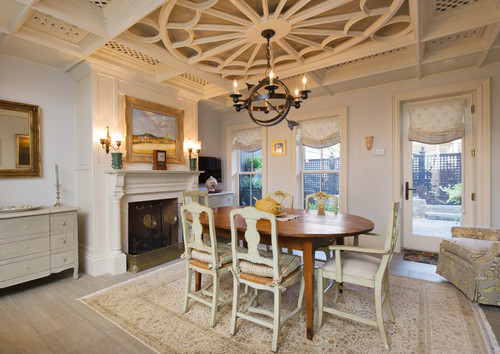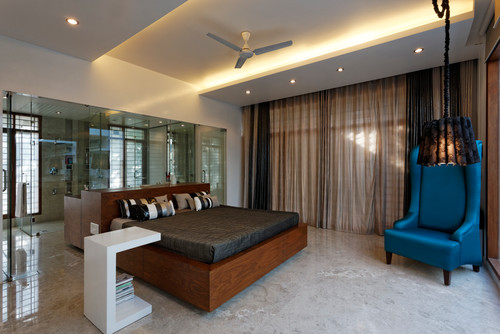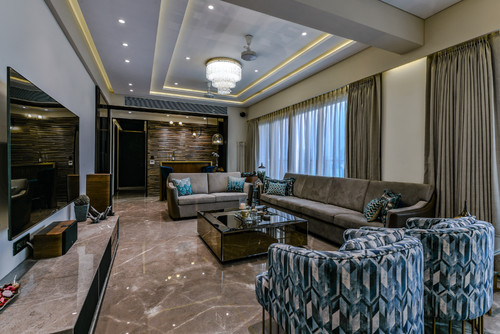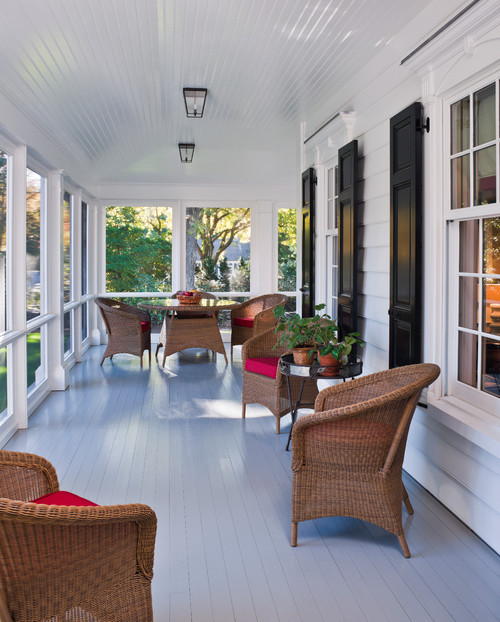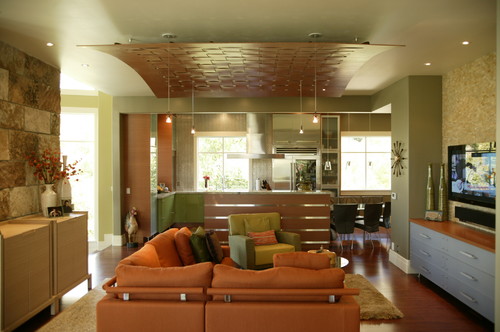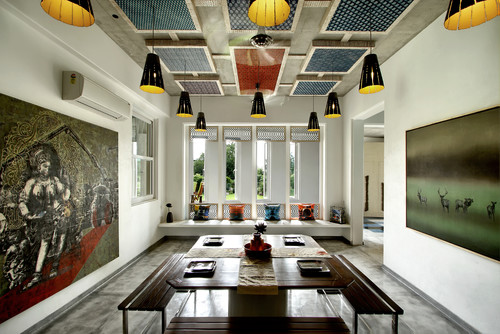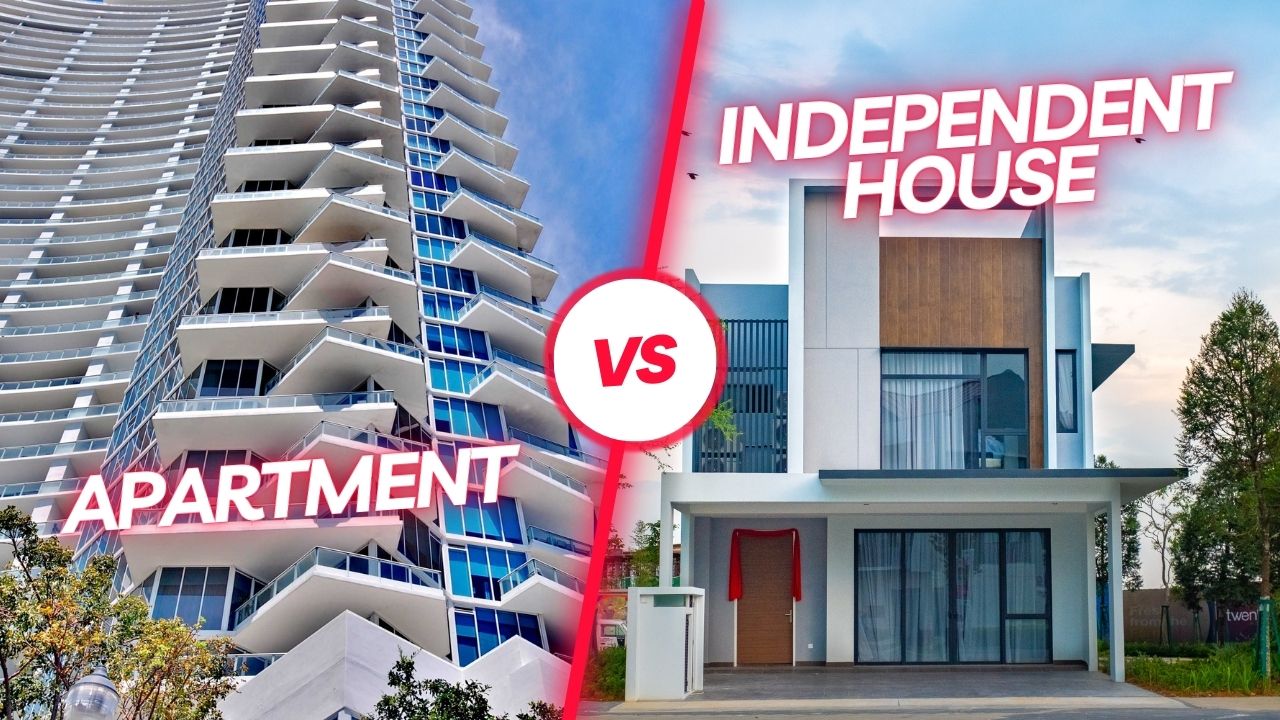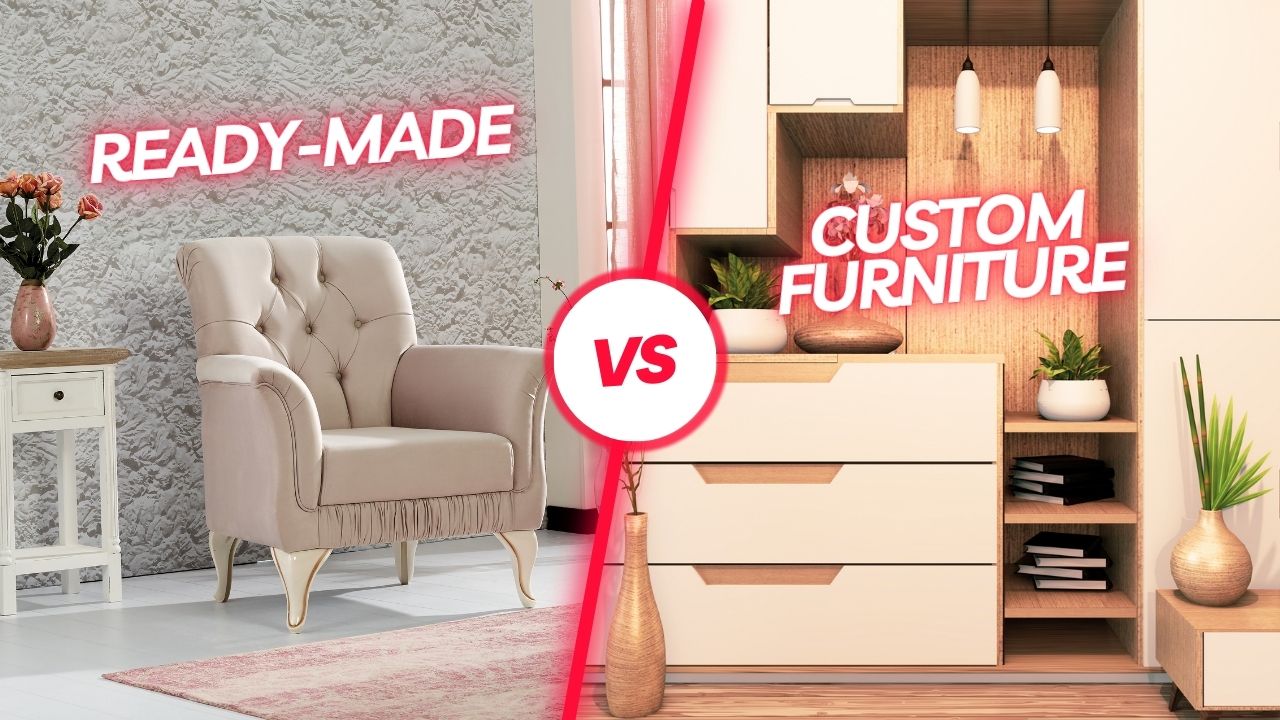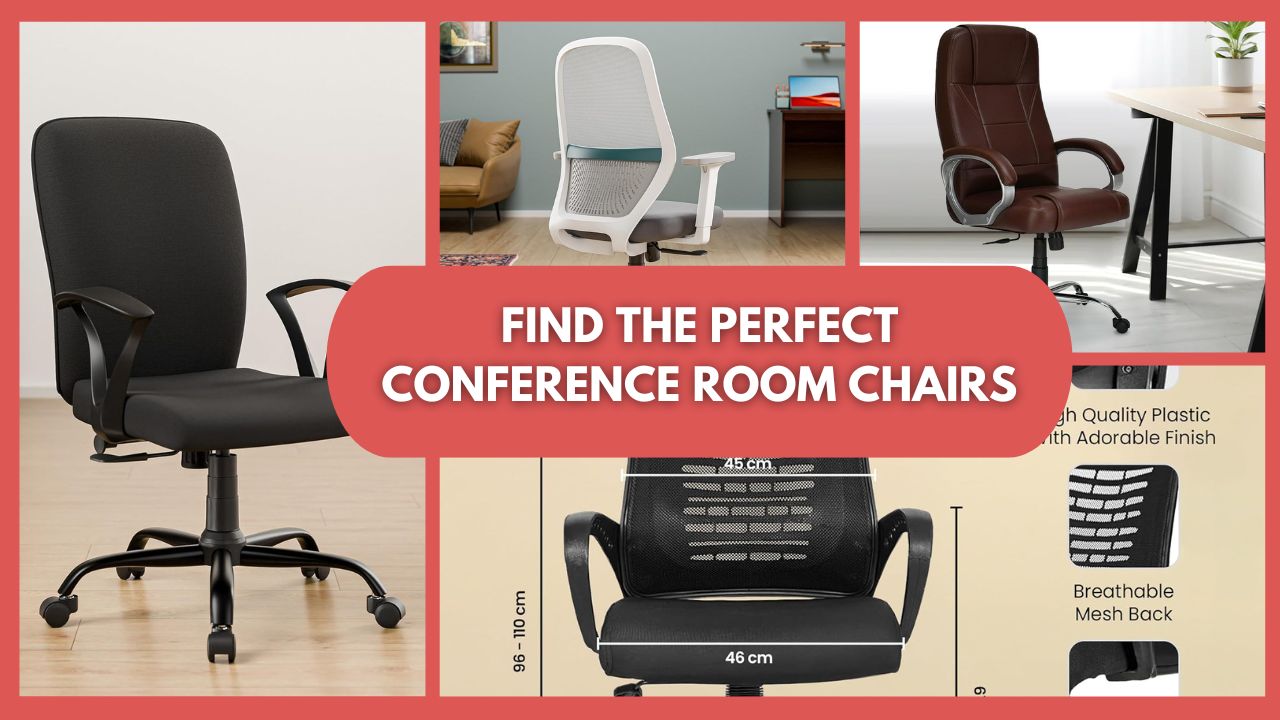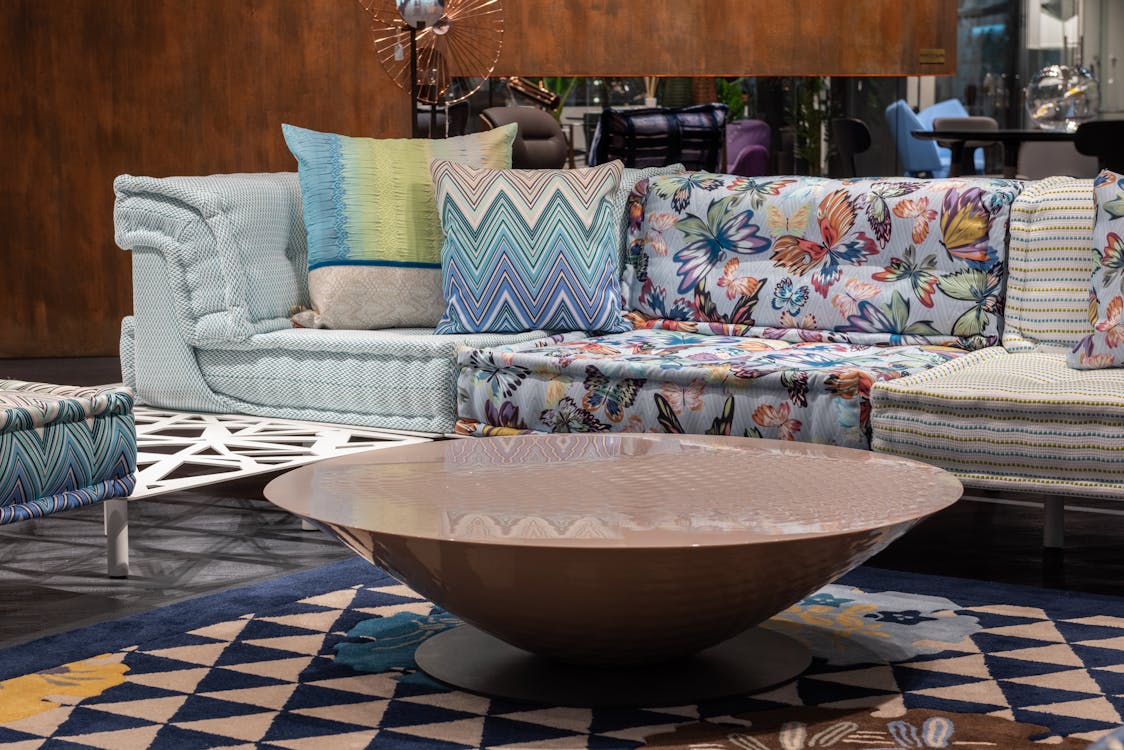False ceilings have evolved from a mere fad to an integral element of modern interiors. The designers play with the most popular false ceiling materials and patterns to design ceilings that enhance the aesthetics of the space. False ceilings could be functional and add to the aesthetics of the overall interiors of a room. False ceilings can be designed to portray the character of the space, create a focal element, conceal wiring and fittings, and so on. These can range from classy to rustic, depending on the choice of the users. To create the false ceiling materials for modern homes with different characters and aesthetics, the following are 7 types of false ceiling materials you must know:
1. Gypsum- Lightweight false ceiling solution
Gypsum is one of the most popular false ceiling materials for interiors. It is popular as it is a light material, which results in the construction of lightweight ceilings. It is available in the form of prefabricated boards of varied thicknesses. The boards are mounted on a metal frame suspended from the ceiling, which can be finished with a coat or two of paint, wallpaper, or laminates.
Gypsum offers excellent fire and heat insulation, making it one of the best false ceiling materials for interiors. These can be easily used to conceal any wiring, ducts or services. Along with being easy to install, these panels generate less dust and offer a less messy process of installing a false ceiling. Though the material comes with its advantages, the major disadvantage of gypsum is that it can be affected by moisture, leading to fungal growth. Therefore, care has to be taken to avoid any kind of seepage to the false ceiling. Another notable disadvantage is that the process of repairs and uninstallation is cumbersome.
Application – These are very versatile and can be used in any space.
Gypsum boards also have a variant, such as perforated plasterboards or Gyptone panels. These panels are essentially used in offices or commercial spaces as they have better sound-absorbing qualities. In addition to helping with better acoustics for space, they also contribute to efficient air conditioning and aesthetics.
2. Wood- Elegant wooden ceilings for luxury
Wood has a timeless quality, making it one of the best false ceiling materials for interiors, imparting sophistication to any space. Plywood, wooden battens, veneers and laminates are used to create wooden ceilings. Wood helps accentuate the beauty of the interiors and imparts warmth and serenity to the space. Wooden ceilings can be used in modern as well as rustic settings. The type of veneer or laminate used for the ceiling can impart a specific language and feel to the space.
Though wood is an expensive material, it can add a factor of panache to your space with its natural texture. Wood is a material that offers high strength and durability. This material can be used to adapt designs such as coffered, panel, textured, suspended, plus-minus false ceilings and the like. This material offers a vast scope of design experimentation. Moreover, the ceilings look classy but require ample maintenance to retain the appeal of wooden false ceilings. One should be careful while selecting this material as it is prone to termites, mold, warping, and many other issues inherent to wood.
Application – Wood false ceilings can be used in an array of spaces – living room, lobbies, bedrooms, etc., depending on the look that goes with the overall design concept and/or the whims of the user.
3. Plaster of Paris (POP)- Flexible designs with POP
Plaster of Paris, or POP, is among the most popular false ceiling materials due to its flexibility and versatility. One can experiment with curves, ornamentations, mouldings, etc., with POP in the picture. It pairs well with other false ceiling materials, making it a go-to choice for many. One disadvantage is that the installation process can be a little messy as the POP paste is prepared on-site and applied onto the suspended mesh and metal framework.
It is one of the most versatile materials for false ceilings as it can be shaped practically into any and every form, thus giving complete design freedom. Apart from being versatile, POP is lightweight, highly durable, and resistant to fire and heat. POP false ceilings are easy to maintain in the long run and can be repaired without much hassle.
Application – POP can create false ceilings in almost any space from residential to commercial.
Confused about false ceilings? Discover the best option for your home with our guide on Gypsum vs. POP: Choose the Best Ceiling for Your Home
4. PVC- Moisture-resistant PVC panels
PVC or polyvinyl chloride ceiling panels have been in the market for several years. These panels are factory-made and extremely light in weight. Being plastic, PVC comes with the advantage of moisture resistance, Which makes it one of the best false ceiling materials for modern homes in areas like bathrooms and balconies. In addition, these are resistant to both termites and fire. PVC panels come in an array of colours, patterns and finishes. These offer high durability, easy installation and maintenance.
Application – PVC is preferred in more moisture-prone spaces like toilets, balconies, etc.
5. Metal- Modern metallic finishes
Metals such as aluminium and galvanized iron are generally used to create impressive ceilings. These types of false ceiling materials are known for their strength, durability, and ease of maintenance. These ceilings can enhance the value of intrigue in the spaces almost instantly. With easy and quick installation, metal false ceilings can become statement pieces in the overall decor. Metals can be used in sheets, panels, bars, etc., to create a striking ceiling. Metallic finishes add sophistication to interiors, making them a preferred choice for false ceiling materials for modern homes.
These can help in adding sophistication and elegance to the space owing to their lusture. These can be treated with a protective layer or coating to protect the metals from any corrosive damage. The sleek appearance of the metal false ceilings is unmatched. These can be moulded into an array of forms (certain limitations depending on the choice of metal would prevail), thus giving a certain degree of flexibility in design. Some metal sheets can also provide crafted results from carving, cutting, engraving, etching, etc.
Tip – The designer should study the metal to be used in-depth while designing the ceiling to do justice to both – the design and the metal of choice.Application – Suitable for any space, often combined with other materials.
6. Glass or Mirror- Reflective elegance with glass
Glass and mirrors are materials that can aid in creating beautiful false ceilings. These can serve aesthetically and functionally very well. However, glass/stained glass and mirror will be used in combination with other materials. Glass in its varied forms – stained glass, etched glass, etc. creates a nice ambience. The backlit glass can amp up the interior spaces and transform them instantly. While glass, with its transparency and translucence, can create a nice ambience, the mirror, with its reflectance, can create the illusion of a bigger space.
Though the material has limited uses but is easy to maintain, these false ceiling materials for modern homes are easy to maintain and provide thermal insulation.
Application – Glass and Mirrors as materials for false ceilings find limited use, though they can practically be used in any space – living rooms, bedrooms, lounges, bar, toilet, bathroom, bar, lobbies, etc.
7. Fabric or Leather- Soft and artistic ceilings
Fabric, leather, leatherette or the like can create soft false ceilings. The fabric can be used for the same if one is looking for merely ornamental false ceilings. The flexibility of these types of false ceiling materials allows for unique designs that set the ambience of a space. The material should not be used solely but in combination with other materials. These are difficult to maintain as they attract dust and mites and, therefore, cannot be considered long-term solutions for false ceilings. However, if framed or empanelled, these can serve longer as a false ceiling. In addition, they can also serve as art pieces.
Application – These can be used in spaces such as lobbies, lounges, bedrooms, living rooms, passageways, etc.
These 7 most popular false ceiling materials provide ample design possibilities for interiors. While certain materials can be universally used, certain materials can be explored based on the project, design, site, requirements or preferences. An interesting false ceiling can be designed using a combination of these materials. This would depend on the type of mood, aesthetics and ambience one is looking for in their spaces. The materials could also be decided based on the longevity of use of the false ceiling. One could even think of coupling materials in a manner that a part of the ceiling is permanent while a part of it uses materials that can be replaced to change the ambience of the space after a specific period. The palette of these 7 materials is sure to help you in your process of achieving a state-of-the-art false ceiling for your space.
Are you still looking for the best false ceiling options? Learn more with Everything About False Ceiling: Materials & Costs
Have other suggestions for false ceiling materials for interiors? Share your thoughts in the comments!


